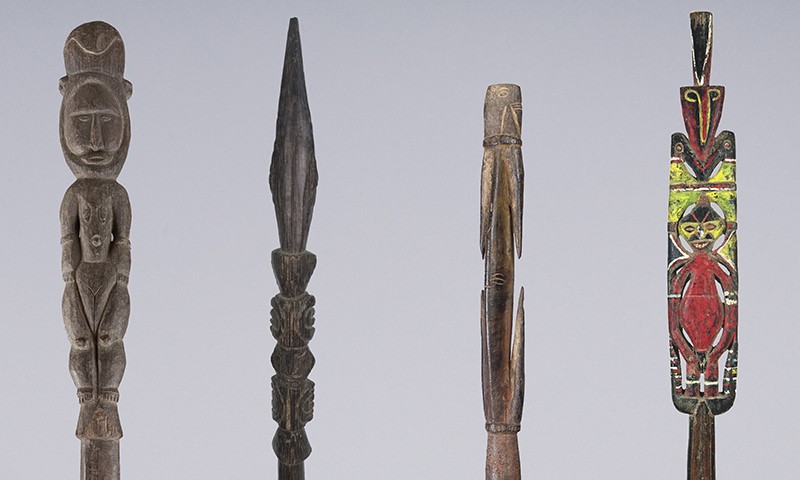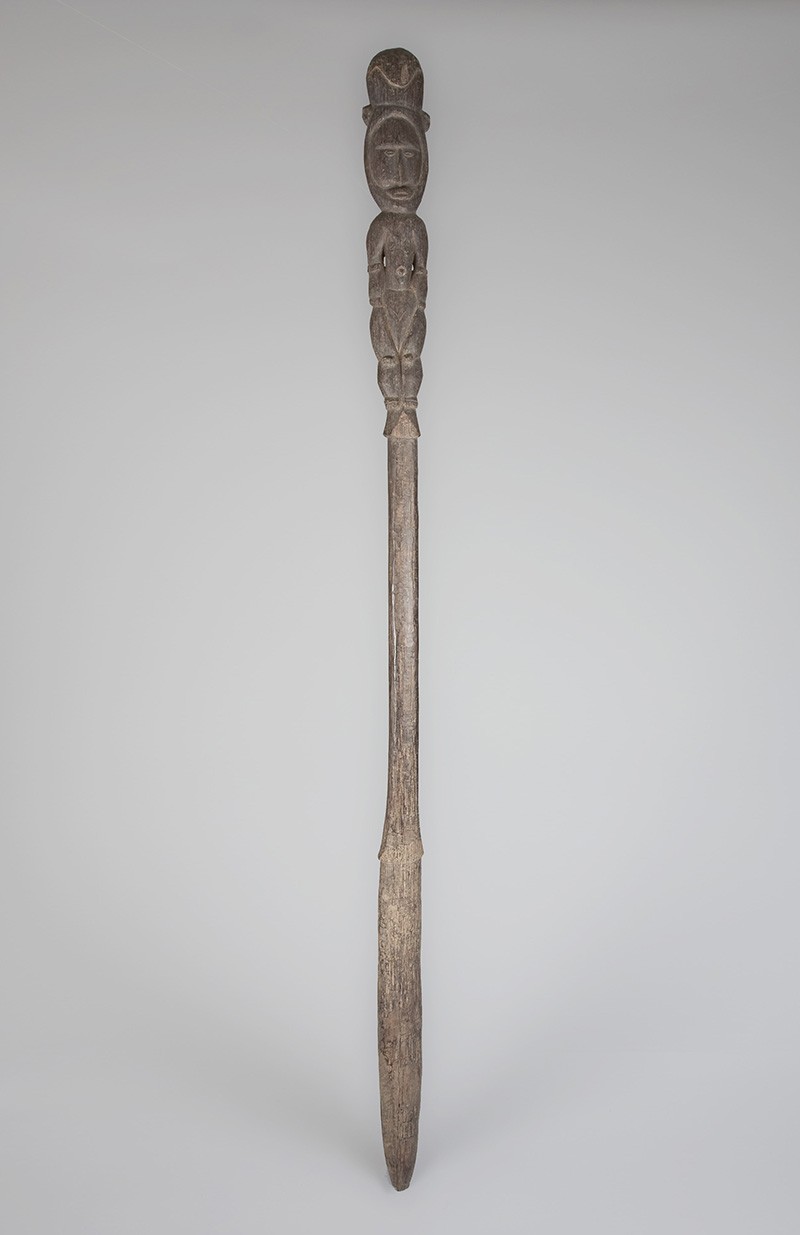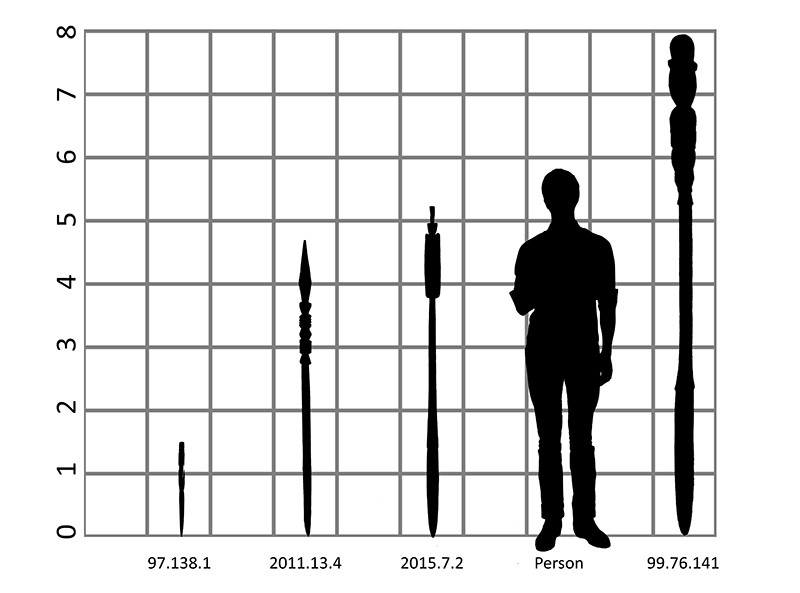 |
Digging Sticks, 20th Century
Abelam culture; East Sepik Province, Papua New Guinea, Melanesia
Wood and paint
99.76.141; 2011.13.4; 97.138.1; and 2015.7.2
Anonymous Gift; Bowers Museum Purchase; Anonymous Gift; and Gift of Mr. Michael Hamson |
Induction
In the United States we understand competition all too well. We compete with neighbors over having the smartest refrigerators and coworkers over imaginary sports brackets; county fairs even provide a forum for comparing the size of one’s produce. While this may be a lighthearted autumnal event for Americans, the growth and ceremonial presentation of giant yams is fundamental to the culture of the Abelam people living on the foothills of Papua New Guinea’s Prince Alexander Mountains. The Bowers Blog has previously discussed the masks used to adorn the giant yams grown by the Abelam, in this post we discuss the tools used in Abelam yam farming and the importance of their design in an otherwise utilitarian object.
Moiety-toity
In understanding the dual roles of yams as food and prestige objects, it is important to know the yams cultivated by the Abelam can be roughly split into two categories: short yams and long yams. The first serves as a favorite staple food of the Abelam, who were up until recently subsistence farmers. These short yams are grown for quantity and generally there are few taboos surrounding their cultivation. The taboo-entrenched growth of long yams stands at odds to this. They can only be grown by men initiated into the yam cult who implement the secret knowledge learned in the great, ornately decorated haus tambarans of each village and use tools they received for reaching certain initiation ranks. For as many as seven months during the growth cycle, interactions with women are forbidden as the sensitive long yams slowly grow to their maximum length of 9 to 12 feet. Fully adorned in masks, shells, and feathers, the yams are presented annually at ceremonies where they are given to one’s exchange partner or tchambera. To not be able to grow a longer yam than the one received from a tchambera is considered an immense dishonor.
 |
At almost 8 ft., 99.76.141 is gargantuan.
Anonymous Gift |
I Yam What I Yam
The complexities of this form of cultivation and the necessity to outperform one’s rival demand an optimized set of tools. The process begins with the subject of this post, the digging stick or gisa. Hard soil is not conducive to the growth of long yams, so the earth must be broken up, removed, and hand-crumbled to give yams the space to grow to their maximum potential. Digging sticks are made from the strong outer layers of black palm trees. For long yams the sticks must be as long as the holes will be deep, meaning that they average eight feet in length. It requires immense strength to raise a gisa high over one’s head and bring it jarringly into the earth like a pile driver, but the process of breaking the earth and removing the soil must be repeated until the hole is deep enough to contend with one’s rival.
 |
| Size comparison chart of the different digging sticks discussed in this post. Person for scale. |
Multitude of Tools
The long gisa is hardly the only tool used, though. Many of the yam diggers in the Bowers’ collections are short enough to indicate they were created either for younger initiates of the yam cult, or for use by women. Even for short yams, planting is mostly done by men due to the belief that women’s hands are not stable enough to work with delicate yams. Despite this confusing rationale, women also represent fertility in the gender dichotomy of the Abelam. Given low yam yields, women might be asked to join in the growth or harvest of short yams for the benefit of a garden’s fecundity. This like explains the shorter-than-standard size of the two digging sticks in the 4 to 5 foot range, though in the case of the pigmented digging stick it may also be a kara gisa, the first stick given to initiates in the yam cult.
In the Sticks
The role of women in yam cultivation does not end with their rare work in planting. Among the diggers featured in this post, we can see both the largest digging stick and the heavily pigmented digging stick are topped by female figures. This is most likely Matboitagwa, the Abelam female primordial spirit who first created yams. Together with the ngwalndu, powerful ancestral spirts who founded individual clans, Matboitagwa assists males in the early stages of initiation in the growth of their long yams. As for harvesting, it is spears called kirku which are used to dig the tubers from the earth. When doing so, one must be extremely careful not to pierce the skin of the yam, as any damage means that it will begin to rot almost immediately. The shortest digging tool featured in this post is a ceremonial version of one of these spears.
Text and images may be under copyright. Please contact Collection Department for permission to use. References are available on request. Information subject to change upon further research.




Comments